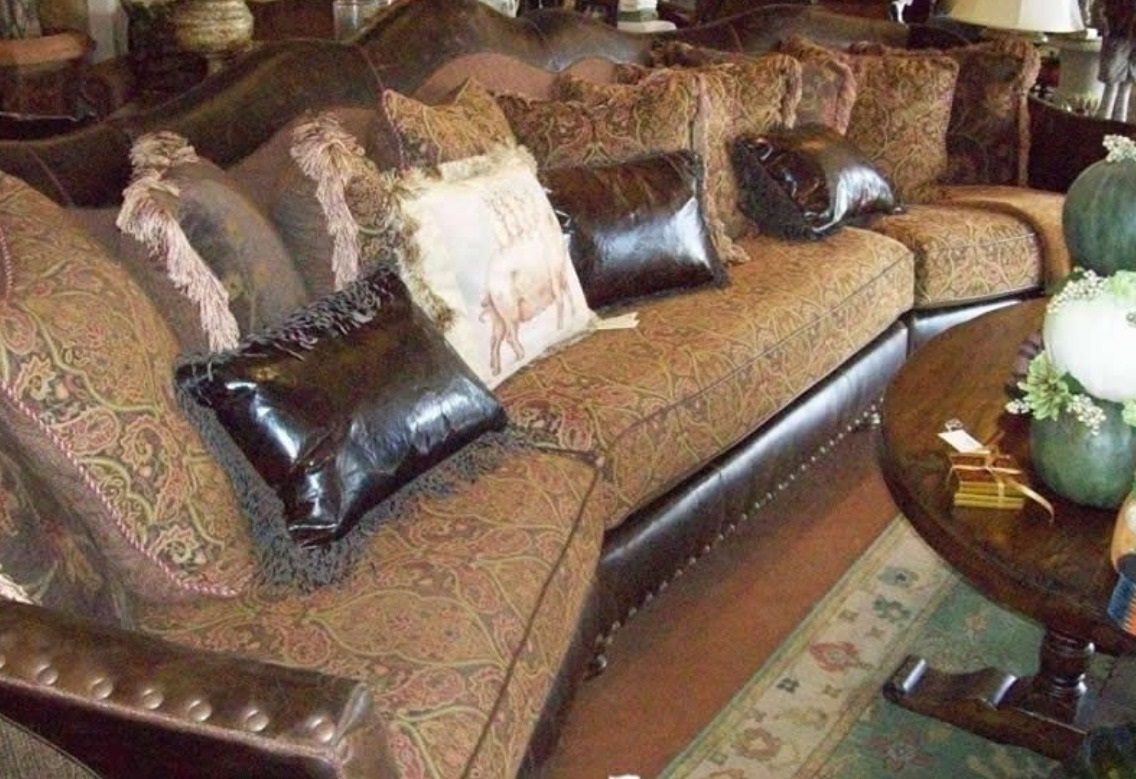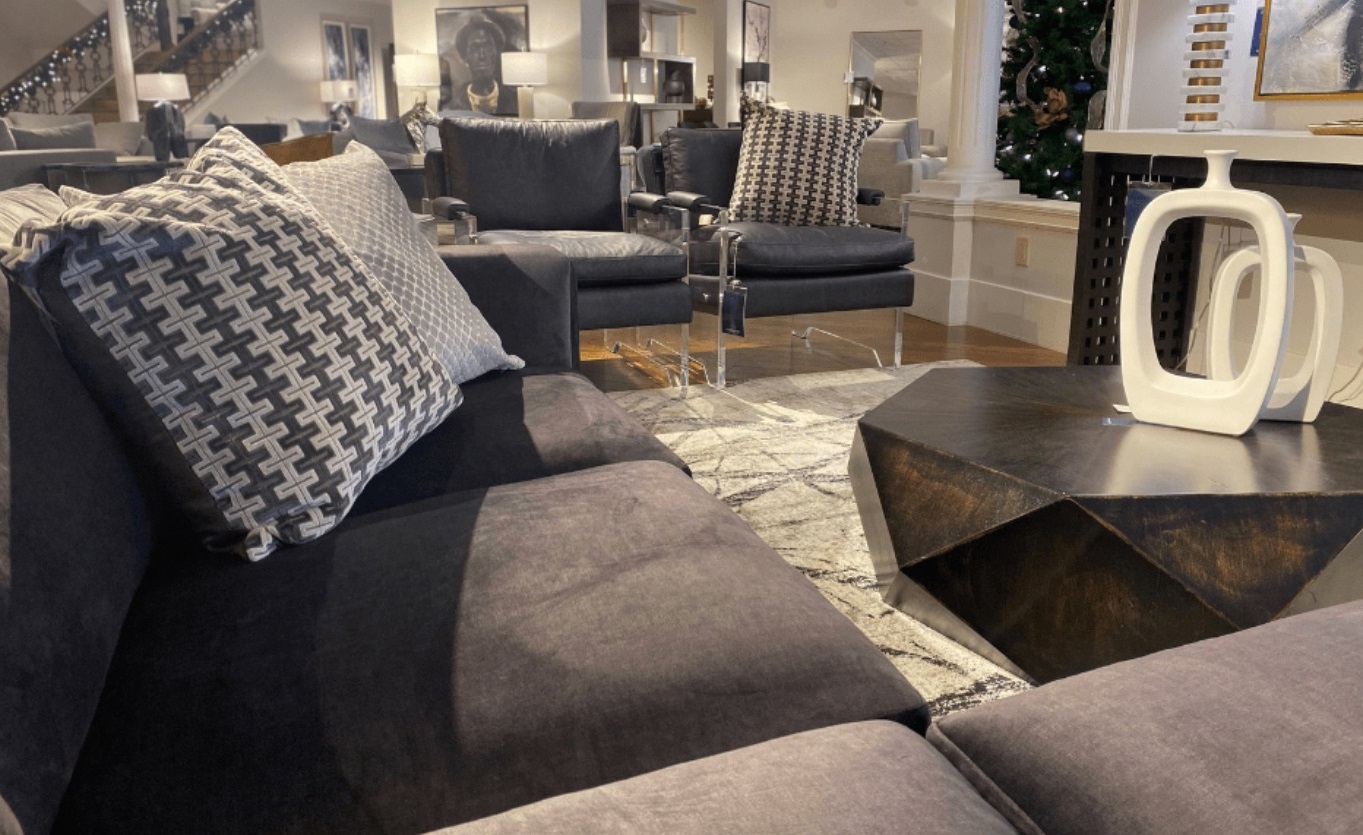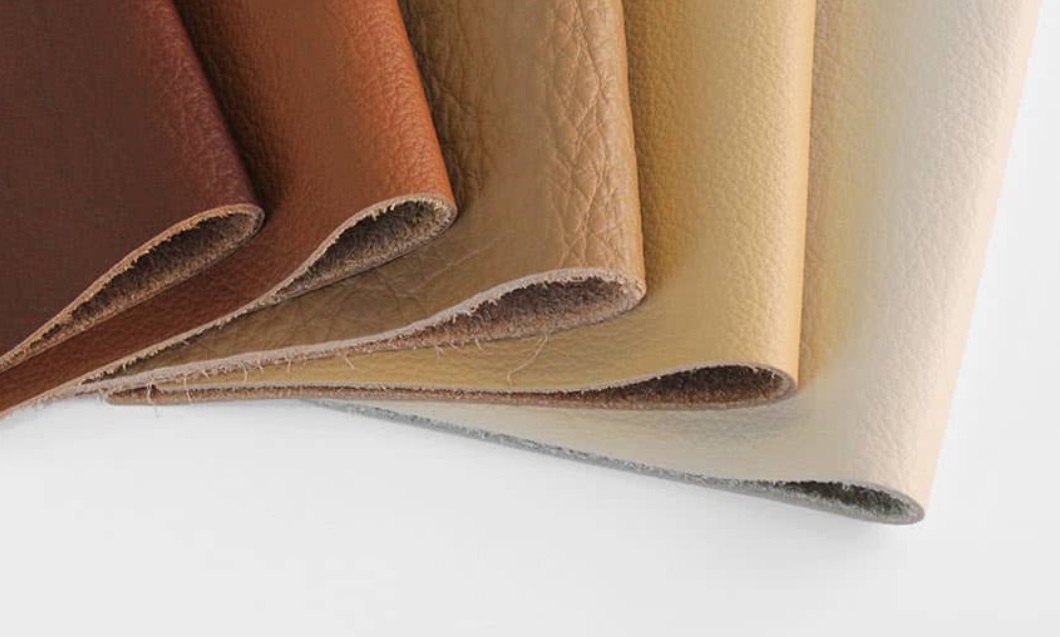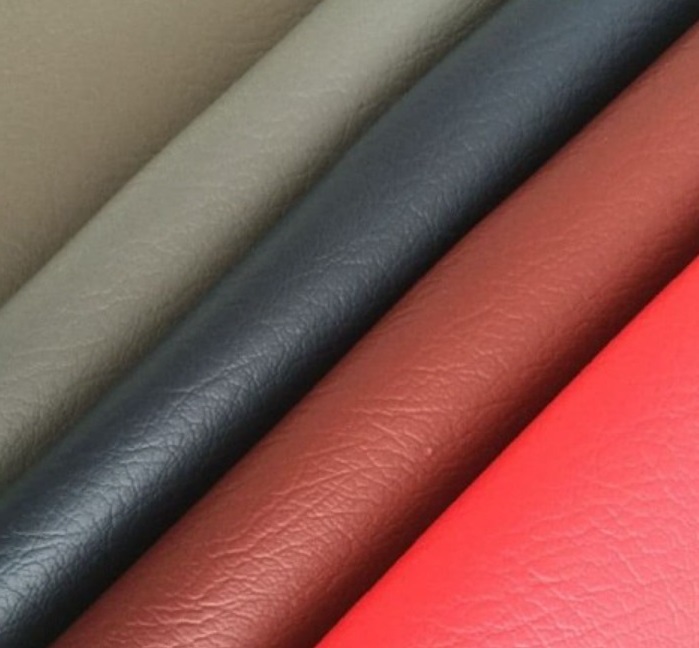Ideally, a sofa or living room will bring you joy for many years. This includes having the top material professionally treated and cleaning it if necessary. It’s not just pets that make sofas face unique challenges every day. On the contrary, everyday life shows that there is always a need for maintenance and cleaning – no matter how sturdy the sofa is.
The way you care for and clean a sofa depends on its material. Leather sofas have very different requirements than sofas with fabric covers.
Complying with the manufacturer’s instructions is also important in the first step. We present some useful tips from “Grandma’s Box of Tricks,” which can be quite effective. However, if the manufacturer explicitly advises against this on their models, it certainly shouldn’t be tried!
It’s a good practice to test new cleaning and maintenance methods on an inconspicuous area first.

Leather sofa – elegant and stylish
Leather sofas are exquisite pieces of furniture with an impressive appearance. But how hard is it to clean? The good news is that it usually takes a little time. You don’t need to do basic cleaning if you also remove coarse dirt directly.
Note: The following tips apply to genuine leather. Since there are many types of leather, you should always follow the manufacturer’s instructions. Or ask when buying!
Tip No. 1: Distilled water helps avoid limescale residue
Are you tired of the remaining water after cleaning the sofa? It does not matter! In this case, you should always choose distilled water when wet wiping the sofa (using a leather cloth). And we mean “moist,” not “wet.” Then, take a second cloth to absorb the moisture.
The rule of thumb: Clean leather sofas weekly with a dry cloth and monthly with a damp cloth.

Tip No. 2: Use alcohol, soap, etc., only on certain skin types!
“Harder ingredients,” such as alcohol or various types of soap, should only be used on certain skin types! This means heavier dirt can often be removed from washable leather with soap and aniline leather with spirit. However, it would help if you were always careful when experimenting. Sensitive skin types, in particular, may be offended by such efforts. In general, it’s best to use neutral soap. If not, using regular soap will make the skin even drier.
Tip No. 3: Sand (only with suede and very carefully!)
Sandpaper is also a tool that should only come into contact with some skin types. However, you may want to remove rough dirt from your suede sofa. In that case, you should start your project carefully (!) with the help of sandpaper. The basic rule in this case is that the stain or contamination must be dry. Then, you can try to remove it gently with sandpaper. The remains can usually be sucked out.
Tip No. 4: Impregnation (seal)
If you buy a new leather sofa, it will often already be impregnated. This is intended to make the material more resistant to stains. This is especially helpful on aniline leather and suede. You will then have to repeat this impregnation regularly, as its effectiveness will be lost over time. When choosing an impregnation agent, ensure it is in harmony with the cleaning agent and your skin type!
Tip No. 5: Breastfeeding milk
The skin dries out over time and then becomes brittle. This is accelerated when exposed to direct sunlight or near a radiator. Ideally, you should avoid this. If this is not possible, use skin care milk. Note: The often-heard tip that you can also use body lotion must be corrected.

Fabric sofas – functional and trendy
Fabric sofas are a classic blend of elegant leather sofas. But how easy is this furniture to clean?
Tip #1: vacuum regularly
Fabric sofas act as dust collectors. To ensure a long service life and an attractive appearance, vacuum the couch regularly (for example, once a week). Many vacuum cleaners offer special attachments that make them more comfortable and work better.
Suppose it is a sofa with a sleeping function. In that case, removing the corresponding part of the sofa once a week and ventilating the upper material also makes sense. Lastly, you can prevent mold from forming.
Tip No. 2: Clean with a damp cloth
As with the leather sofa mentioned above, wiping with a damp cloth can remove dirt. Again, use distilled or boiled water and a simple leather cleaning cloth.
Tip No. 3: Commercial cleaning products
You often use commercially available cleaners to remove heavy dirt from a sofa. Of course, paying attention to advertising promises and understanding the manufacturer’s specifications is also essential. This ensures that nothing gets in the way of gentle yet effective cleaning.

Clean it or buy a new one?
So, there are some great tips and helpful cleaners to extend the life of your sofa. After several years of use, the question sometimes arises as to whether cleaning is still worth it.
On the one hand, the right tools can achieve a lot. On the other hand, this does not prevent the aging of the upper material. While a well-cared-for leather sofa often becomes more beautiful with time, fabric sofas have a limited lifespan.
If the upholstery is worn out, buying a new one may be a good idea.
The Intriguing Tale of Leather Sofas
The History of Leather Sofas
Envision entering a living room featuring a rich, natural leather sofa. The impact is immediate: You feel compelled to run your hands across its cool, smooth surface. The leather yields to your touch and emits a satisfying creak. Yes, it’s genuine. And you wish to linger in this lavish, welcoming space indefinitely. Leather has been utilized for millennia for clothing, armor, and even as a material for constructing tents by nomadic tribes. The process of transforming raw animal hides into a supple material that is easy to dye, sew, and wear or upholster has existed for centuries. It’s an ancient craft steeped in history and tradition.
Leather upholstery, whether in the form of chairs or sofas, also boasts a lengthy and captivating history. Were you aware that leather upholstery has adorned homes for thousands of years?
Evidence suggests that the thrones of Arab rulers were crafted from leather. Sitting on leather denoted privilege and signified power and wealth. In Roman society, leather lounge chairs could be found in the homes of the wealthiest and most influential nobles. Men would recline in these chairs while indulging in meals, drinks, and business dealings, while women would sit on simple wooden chairs.
Due to the labor-intensive nature of leather production, it was reserved for the elite. It was highly costly, and owning leather furniture was deemed a status symbol.
Leather Sofas – From the Middle Ages to the Industrial Revolution
For quite a while now, leather has been employed in various household items, including chairs and sofas. Increased trade between Europe and Asia, as well as the discovery of the Americas, brought new types of furs and hides to Europe, heightening interest in leather.
However, the process of leather production remained laborious and expensive, and leather furniture remained a luxury reserved for the affluent. Leather sofas could be found in the abodes of royalty, kings, and nobles. Commoners still had access to leather in the form of clothing and small accessories, but furniture was beyond their means.

The Industrial Revolution and Leather Furniture
We are all familiar with the developments during that era: new machinery bolstered production, and innovative techniques made it simpler and more cost-effective to create everyday items. People ceased crafting their own household items, as they had done previously, and started purchasing them from manufacturers.
Leather was no exception to industrialization. Although certain steps still required manual labor, the discovery of new dyes and tanning methods contributed to the proliferation of leather goods, including furniture. In the 19th century, leather sofas began to grace middle-class homes. Leather chairs were no longer the exclusive domain of the wealthy and influential.
Leather sofas became synonymous with comfort and home; a home lacking even a small leather chair or sofa was deemed unsuitable for entertaining guests. The introduction of new colors and types of leather made it easier to incorporate leather furniture into various decors. The Victorians were ardent home decorators.
The 20th Century
As the 20th century progressed, technology advanced and international trade flourished. Leather sofas remained an indispensable piece of furniture, usually in the form of a chaise longue, where men would relax after a long day at work. Leather sofas served as the focal point of the living room, where families gathered to listen to the radio and later watch television.
In the 1960s, leather sofas gained popularity. Fashion and furniture designers began using leather more extensively, and leather appeared in hues such as white, vibrant green, and red. The renowned pod chair frequently featured leather upholstery. A home would not be considered fashionable without a leather sofa.
Leather Sofas Today
Since then, leather sofas have upheld their reputation as the ultimate luxury furniture. Leather furniture instantly adds a sense of opulence and comfort to any living room and is still regarded as a status symbol, despite being more accessible and less expensive.
Today, leather sofas are available in colors that were previously unimaginable: pink, purple, turquoise, and orange. Leather sofas are now as adaptable as fabric sofas and can complement any style and decor. However, excessive use of leather can appear ostentatious; you can temper it by incorporating throws and pillows in complementing or accent colors. Alternatively, you can enlist the services of an interior designer.
Fascinating Information about the Historical Development of the Leather Industry
The present-day statistics about the leather industry are truly remarkable. Approximately 23 billion square meters of leather are sold globally every year. How did this come to be? Where did it originate, and when did leather first become a part of the crafting industry? You might be curious about the origins of leather crafting and its evolution through the ages.

History of Crafting Animal Skin Materials by Humans
In ancient times, early humans hunted animals for sustenance. They would skin the animals and utilize the hides for shelters, clothing, and footwear. The earliest evidence of using animal skins dates back to the Paleolithic era, as indicated by numerous cave paintings depicting the utilization of animal hides. Additionally, Paleolithic sites reveal tools used for removing animal hair and cutting skin.
Without proper preservation, animal skin would deteriorate. Therefore, preservation methods were essential. The earliest method of preserving animal skins involved burying them in soil followed by drying. Another method involved allowing the hides to tan in the forest, changing color due to exposure to plant-based vegetation.
The primitive process of tanning animal skins involved removing fat and drying the hides in the sun, which was a time-consuming process. Subsequently, various salts and sulfur were discovered, leading to the chemical tanning of animal skins with the aid of salt and other chemicals. Over time, the tanning process evolved, and the first tanned hides were treated with alum and dyed using plant-based dyes. This marked the beginning of centuries of leather-making process development, resulting in more efficient and effective production processes for leather materials.
In addition to using salt, animal hides were previously preserved using methods such as smoking, oiling, and even using extracts from wood. Initially, the practice of coloring leather to brown or tanning hides involved the use of wood extracts, eventually evolving into the art of leather tanning. This craft was initially kept secret and passed down within the leather-making community, known as the leather trade guild.
In the 18th century, the world transitioned into the first modern industrial era marked by the discovery of machines and electricity. This transformation also revolutionized the processing of animal hides. The demand for leather materials surged in the market, leading to the modernization and diversification of the tanning process. The final finishing of leather materials involved using various dyes, and by the early 19th century, chrome tanning and specialized tanning for animal hides had been developed.
How Does the Current Process of Crafting Animal Skin Work?
The contemporary leather crafting industry has made significant advancements in the development, discoveries, and innovations in producing high-quality leather materials. The commercial leather material industry continues to expand and progress.
Currently, the processing of raw animal hides into leather for crafting typically involves three stages:
Pre-tanning or beamhouse
This stage, also known as the wet processing stage, aims to preserve raw animal hides until the tanning process. The processes involved include soaking, liming, deliming, bating, and pickling, with each stage focused on removing fat, fur, epidermis, and animal glands, eliminating lime, and acidifying the hides to prepare them for the tanning process.
Tanning
The tanning process varies based on the type of tanning material used, such as vegetable tanning, chrome tanning, a combination of both vegetable and chrome materials, and synthetic tanning. This process includes dividing leather materials into two groups: hides for large animals such as buffalo, horses, and cows, and skins for sheep, goats, and reptiles.
Tanning materials can influence the final outcome. Vegetable tanning results in a light brown to red color, producing soft but rather stiff and not heat-resistant leather. On the other hand, chrome tanning typically yields flexible, limp, soft, and more heat-resistant leather. Combination tanning involves using a mix of tanning materials to leverage the benefits of each. Synthetic tanning is similar to vegetable tanning but uses different materials, specifically organic polyacid materials.
The finishing stage involves several processes: shaving, bleaching, neutralizing, base painting, oiling or fat liquoring, fattening or oiling, drying, moisturizing, and stretching.
The purposes of these finishing processes are as follows:
Tanning is performed to ensure the leather has uniform thickness, while bleaching is carried out to eliminate iron spots and reduce the pH level. In chrome tanning, neutralization is necessary due to its high acidity, to prevent damage to the leather. Subsequently, painting is done to impart color to the leather, and oiling is aimed at lubricating the leather fibers to enhance resistance and flexibility, while also preventing the fibers from sticking. Fattening or oiling is intended to remove the tanning agent from the leather’s surface. Drying stops the chemical processes in the leather and removes the water content. Moisturizing adjusts the leather to the surrounding air, and stretching maintains the leather’s flexibility to prevent easy stretching after completion.

What Is Faux Leather?
Faux leather, also known as synthetic leather, is a petroleum-based substitute for real leather. It shares many properties with real leather but does not involve the use of animals in its production.
Similar to real leather, faux leather is soft and water-resistant, making it highly stain-resistant and easy to clean. While it’s less durable than real leather, it’s resistant to abrasion and cuts, making it suitable for upholstery in homes with children or pets.
Most faux leather is manufactured in the same colors as real leather, but it can be produced in any color. Some manufacturers have even experimented with yellow, green, purple, or blue faux leather to differentiate their products.
Faux leather is a popular fabric for outerwear like jackets and coats because it provides insulation similar to real leather. While it can be challenging to distinguish faux leather from real leather at a glance, the touch is the key differentiator; faux leather feels like plastic, setting it apart from real leather.
While faux leather is commended for not requiring the killing of animals, environmentalists criticize its lack of biodegradability and the release of harmful chemicals during production. To address these concerns, some manufacturers have started producing faux leather from plant-based materials, offering a potential solution to both the ethical and environmental issues associated with real and faux leather production.
How Faux Leather is Created
Faux leather can be produced using various manufacturing methods. For instance, Presstoff is created by treating paper pulp with a special resin to enhance the durability of the plant-based material. However, historically, Presstoff’s inability to withstand moisture and bending has limited its widespread production.
Most faux leather available today is crafted from a textile base coated with a plastic material. The predominant plastics used in faux leather production are polyurethane (PU) and polyvinyl chloride (PVC). While the processes for making these plastics differ slightly, the bonding of the plastics to the base fabric is quite similar.
- Acquiring the Base Material
Many faux leather manufacturers utilize cotton or polyester as the base material for their fabrics. The polyester or cotton fabrics used as the base material for faux leather are typically porous and rough, requiring special manufacturing. Occasionally, faux leather manufacturers may produce their own base material, but it’s more common for them to source it from a third-party manufacturing facility.
- Formulating the Plastic
Faux leather manufacturers then need to create the plastic substance that will be bonded to their base fabric. For example, PVC is produced by combining salt and petroleum elements. Chlorine is generated by subjecting salt to electrolysis, which is then combined with ethylene derived from petroleum.

This process results in ethylene dichloride, which is converted to vinyl chloride monomer at high temperatures. The monomer is then transformed into a polymer with polyvinyl chloride resin. To ensure flexibility, plasticizers are added to this petroleum product, allowing it to bond to the base fabric used in faux leather production.
The process for making PU is more complex and involves isocyanates, polyols, and various additives. The different polymers used in PU production are reacted with each other and then processed. The PU used in faux leather production is exposed to plasticizing additives to produce a flexible final material.
- Bonding the Material
Subsequently, faux leather manufacturers bond the PU or PVC to the base textile. Various methods can be employed, but they generally involve melting the plastic and coating it onto the base textile.
- Cutting and Preparing the Fabric
Once the plastic has been bonded to the underlying fabric, it is cut into the desired shape and size. Typically, faux leather is sold in long strips by the yard.
Applications of Faux Leather
Faux leather serves as a direct substitute for real leather and is used for similar purposes. For example, upholstery is a common application of faux leather. Sofas, car seats, chairs, and coffee tables frequently feature synthetic leather upholstery, and it is also used in certain types of wall hangings.
In the realm of clothing and accessories, faux leather is commonly utilized in handbags, shoes, boots, gloves, and hats. It is also popular in outerwear such as jackets, although it does not withstand weather conditions as well as real leather. Other uses for faux leather include luggage, briefcases, watch straps, smartphone cases, and camera cases.
